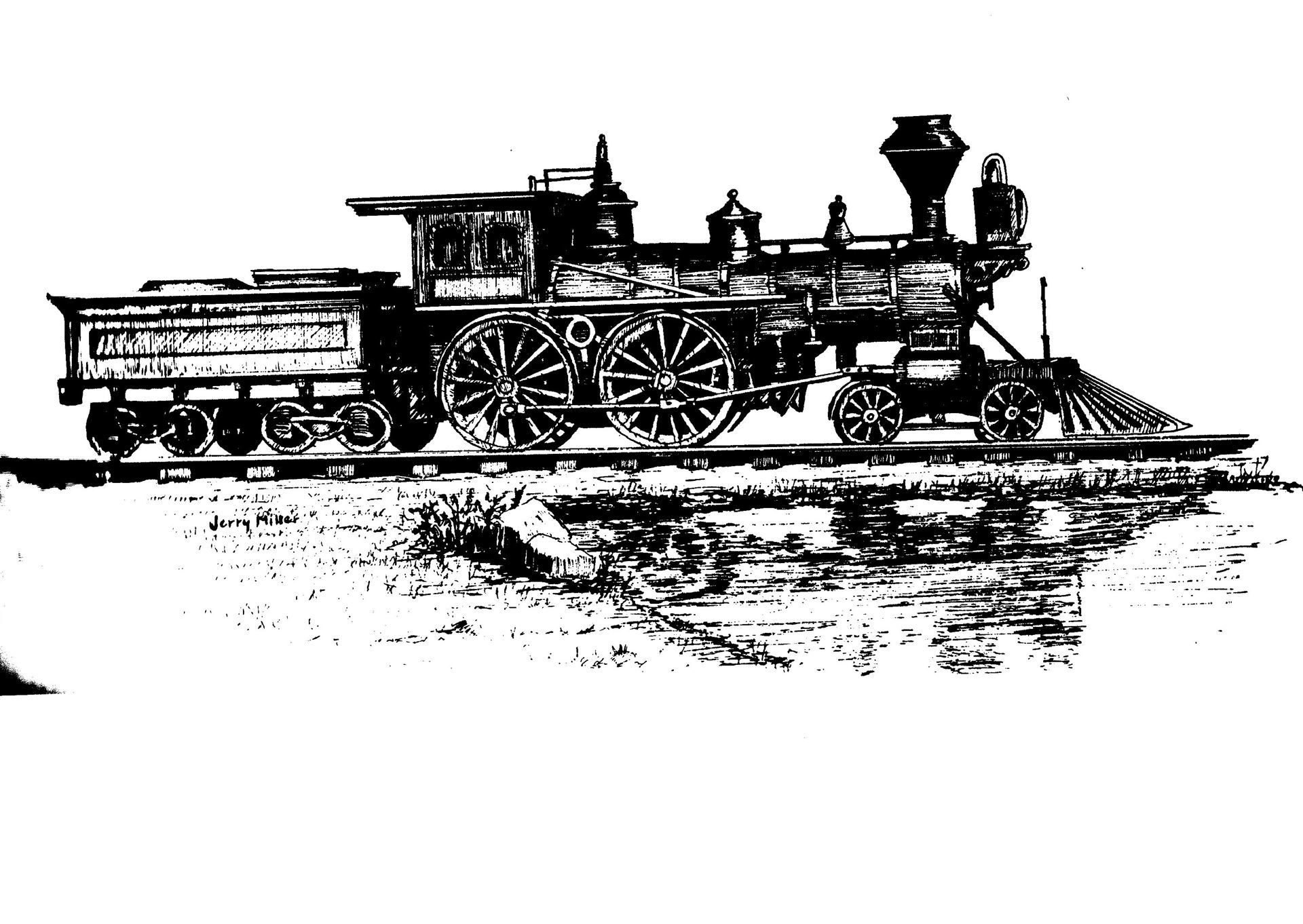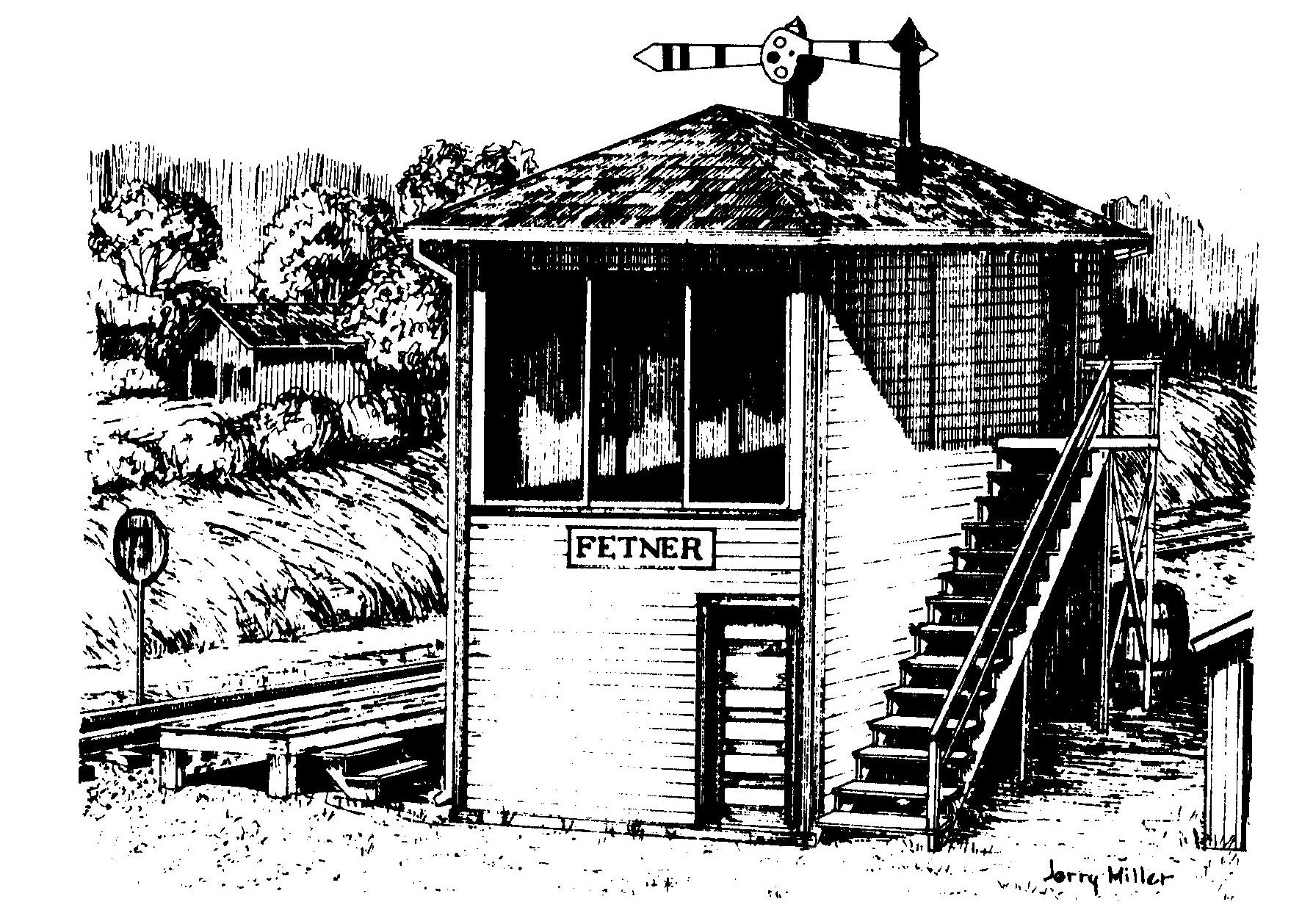A BRIEF HISTORY OF THE RAILROADS IN CARY

1895 Steam Train
Drawing Courtesy of Jerry Miller
The railroads literally put Cary on the map in the mid-19th century. Here are tales about how important trains have been to our town. Historic content was taken from the book, Around and About Cary, by Tom Byrd and Jerry Miller. Many of Jerry Miller’s drawings are also included. Additionally, the transcripts from oral history interviews provided the majority of the information herein. Almost 100 interviews have been conducted with long-time Cary residents who shared their memories with members of the Friends of the Page-Walker history center, so those histories could be documented for posterity. Each narrator is named as a contributor.
THE NORTH CAROLINA RAILROAD (NCRR)
TOM BYRD (From his book, Around and About Cary): In the 19th century, North Carolina provided most of the funds to build a railroad across the state. Chartered in 1849, the railroad right-of-way was surveyed through Cary in 1851, passing in front of the home of the Pharis Yates house. The railroad was built mostly by slaves, beginning in 1853, with steam engine train service beginning along the entire 223 mile-line in 1856. The railroad literally put Cary on the map.
Morrisville got the first railroad station in the area, and Cary got a sidetrack where eastbound and westbound trains could pass each other. By 1860, a rural depot had been established. Frank Page was the agent, so it became known as Page’s Turnout. In 1862, NCRR prevailed the Southern Express Company to build a telegraph line through Cary. Because the trains began to stop occasionally for passengers, Frank built a small shelter for those waiting for a train to stop for them. By 1867, there was regular passenger service in Cary.
In 1868, a junction was formed in Cary when NCRR allowed the Chatham Railroad to lay tracks “not less than 8 feet from their own,” and to cross the tracks near Cary. In gratitude, the Chatham railroad (later called the Seaboard) then built a “commodious depot” in Cary. Frank Page sold ten acres of land for the right-of-way for the depot at a cost of $2.00.
Over time, the two original railroads changed ownerships and names. In 1893, the Chatham Railroad became the Seaboard Coast Line System. In 1895, the Richmond and Danville Railroad Company became the Southern Railway Company.
In the 1860s, NCRR built what became known as the Southern station. To the horror of many Cary citizens, it was demolished in 1939. Then both train companies began to use the Seaboard station (the original “commodious depot,” and the name was changed to Union station. Then it was also torn down in 1965. The current Cary depot was built and opened in 1995.
MEMORIES ABOUT CARY’S TRAINS FROM ORAL HISTORY INTERVIEWS
CLYDE EVANS JR.: The trains were the Seaboard and Southern. They had steam engines when I was a child, there weren’t any diesel engines like it is of this day. Steam engines would come through Cary, one on the right and one on the left. There were two stations then between the two tracks, one for the Seaboard and one for the Southern, and they sold tickets right there. Both would go to Raleigh but the Southern stopped all the time. The Seaboard didn’t stop too much, unless it was necessary.
WARREN WILLIAMS: My father was a brakeman and flagman on the railroad that came through Cary. He often noticed this old brick building standing by the tracks. He was later able to buy the Page-Walker Hotel building for our home in 1939. One of the biggest enjoyments of living at the Page-Walker was sitting on the balcony and watching the Silver Medium Shooting Star, or Silver Star on the railroad, which was the Seaboard Airline Railway at that time. We got great enjoyment seeing the trains come through.
TRAIN SWITCHES
C.Y. JORDAN: It’s been said that my ancestors, Pharis and Alvis Yates, gave the land here for the railroad to come through. Several of my family were railroad people, including myself. I worked for fifteen years for railroads.
My father had a brother named Carlos Yates. That would be my uncle. He was killed in an accident at age twenty working on the railroad. He was a brakeman. I was named for him. My mother’s father was a section foreman. She had two brothers who worked on the railroad. One of her brothers was also killed in an accident. It was dangerous work in those days, especially for the brakeman. They would walk the top of the boxcars while they were moving. I’ve seen them many times when I was a boy, walking down the top of a moving freight train. He mis-stepped and went down between the cars, well...
When I was working for the railroad, they were beginning to become very safety conscious. Now they’re extremely safety conscious. They wouldn’t allow any personnel to board or de-train from a moving train. That tells you how conscious they are of safety.
My father went to work as a brakeman at age sixteen. His grandfather Henry taught him the telegraph, so he became a telegraph operator. From there he left train service and became a telegraph operator and a train dispatcher. Then he pursued other ways of making a living.
WARREN WILLIAMS: In the early days, where there were telegraph poles indicated where the railroad came by. When they built the station house, they built much heavier lines. They had these two or three lines coming across that went down to the Fetner tower. The tower was where a man would work twelve hours a day, then another man would come to take his place. They would throw the switches to move the tracks in and out, to put a train on the sidetrack, or over on the main track. He had to watch what he was doing particularly well and be abreast of the times to keep the trains from getting into one another.
Fetner tower was there until they torn the Cary station down. Then they went to an automatic type system which they worked out of Raleigh. My daddy had a first cousin that was a telegrapher down at Raleigh, and he was put in charge of throwing the switches from Raleigh to Hamlet, North Carolina. I forget how many miles it is across there. He would sit and watch all the train tracks on a great big board in front of him. He could see a train coming with a marker coming up and getting close to a sidetrack, and see another train coming, and he’d push the right buttons to put this train on the sidetrack, maybe twenty-five miles from where he was sitting. He would press another button to let this train by. It was such a precise job, you had to be real careful with it. He would sit in the chair with his mind right on what he was doing, because if it wasn’t done right, it could be a terrible catastrophe. His chair was rigged so if he had a heart attack or fell over, this thing would automatically cut off until somebody could come and relieve him. Now the new computers probably control all of that. Computers are so smart, they can do anything with a computer, you know.

FETNER TOWER
Drawing: Courtesy of Jerry Miller
C.Y. JORDAN: When I was a teenager during World War II, my father would work sometimes down at Fetner tower, the interlocking plant. I was familiar with the other fellows that worked the other shifts down there. One in particular, old man Sam Smith, lived here in Cary. If I didn’t have anything else to do, I would go down in the afternoon and stay with Mr. Smith. During those years of World War II, we would have ninety trains through here a day, sometimes a hundred in a twenty-four-hour period, moving troops, everything. Freight trains weren’t as long as they are now due to the power of the steam engines. The most you would ever have would be two engines coupled together, a double-headed engine. There’s only so much tonnage that they could accommodate. Now there are big diesel engines, and they can put four or five of them together to carry a train a mile and a half long with a hundred and fifty cars, which is close to two miles long. So, the frequency was much greater during the war when you have steam engines. Everything was steam powered.
Ninety to a hundred trains kept that operator, Mr. Smith, busy. By then the telegraph system had about run its course and telephones had taken over. He gave me a headset so I could listen to what was being said up and down the road. The dispatcher was operating the trains. I’d help Mr. Smith some, throw the levers to line up for different trains coming from other directions.
I had one year in the Navy at the end of World War II. Then I had been working for the railroad when I was called up into the Army for the Korean War. When I got home from that in the early 50s, I went back to my job with the Seaboard Airline Railroad on Halifax Street until 1955. Then I came back to Cary and began working with my brother as a real estate developer. Things slowed down, so in 1967, I went back to work with the railroad as an Assistant Division Engineer. Worked there another ten years.
We had accidents, train wrecks, derailments, bridges burned, a landslide covered the track over in Alabama. All kinds of things going on over that much territory. I was sent out to many problems or disasters. If it was a wreck, we’d have to get it cleared off the track, then build the track back. The worst one I responded to was a little, local passenger train that ran from Birmingham into Atlanta. It struck an earth-moving piece of equipment on the track and derailed the train. But it turned the rail over and that guided the derailed train right on down the track until it came to a stop, so it didn’t do a lot of damage. Nobody was injured to any extent. While I was in Raleigh, the Silver Star derailed on two different occasions for various causes, cause unknown on one of them. I had never been involved in anything serious, to the extent of fatalities. Most of the derailments on the railroad were due to freight trains or equipment. In the old days before they had roller bearings, they’d have what is known as “hot box,” and that would cause a wheel or axle to break and derail the train. They were never all that serious, but we had to clear it up quickly because there were other trains rolling.
